- Books Name
- Kaysons Academy Maths Foundation Book
- Publication
- Kaysons Publication
- Course
- JEE
- Subject
- Maths
Cartesian System
You have studied the number line in the chapter on ‘Number System’. On the number line, distances from a fixed point are marked in equal units positively in one direction and negatively in the other. The point from which the distances are marked is called the origin. We use the number line to represent the numbers by marking points on a line at equal distances. If one unit distance represents the number ‘1’, then 3 units distance represents the number ‘3’, ‘0’ being at the origin. The point in the positive direction at a distance r from the origin represents the number r. The point in the negative direction at a distance r from the origin represents the number −r. Locations of different numbers on the number line are shown in Fig.

Descartes invented the idea of placing two such lines perpendicular to each other on a plane, and locating points on the plane by referring them to these lines. The perpendicular lines may be in any direction such as in Fig. But, when we choose
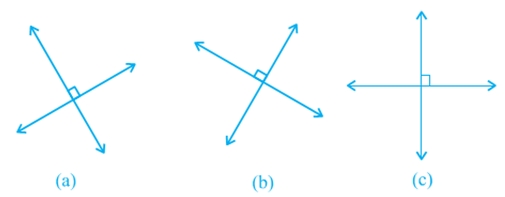
these two lines to locate a point in a plane in this chapter, one line will be horizontal and the other will be vertical, as in Fig.(c).
These lines are actually obtained as follows: Take two number lines, calling them X′X and Y′Y. Place X′X horizontal [as in Fig.(a)] and write the numbers on it just as written on the number line. We do the same thing with Y′Y except that Y′Y is vertical, not horizontal [Fig.(b)].
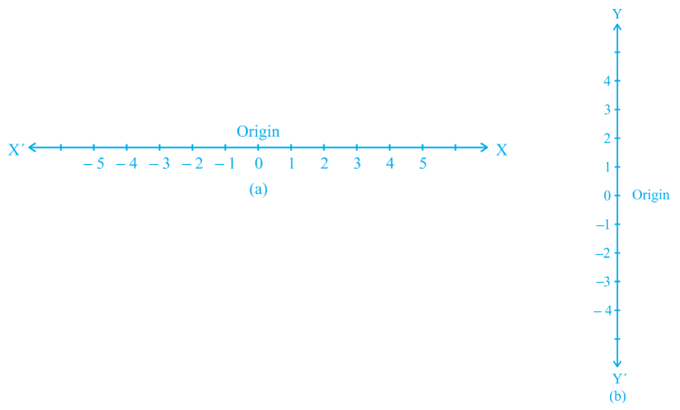
Combine both the lines in such a way that the two lines cross each other at their zeroes, or origins (Fig. 3.8). The horizontal line X′X is called the x - axis and the vertical line Y′Y is called the y - axis. The point where X′X and Y′Y cross is called the origin, and is denoted by O. Since the positive numbers lie on the directions OX and OY, OX and OY are called the positive directions of the x - axis and the y - axis, respectively. Similarly, OX′ and OY′ are called the negative directions of the x - axis and the y - axis, respectively.
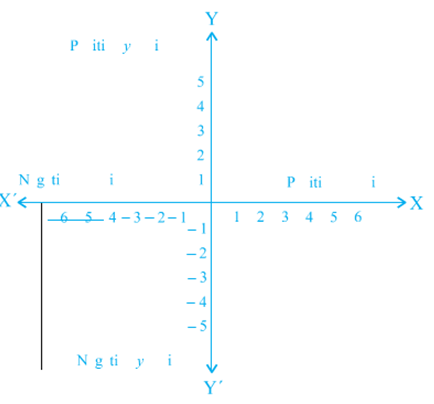
You observe that the axes (plural of the word ‘axis’) divide the plane into four parts. These four parts are called the quadrants (one fourth part), numbered I, II, III and IV anticlockwise from OX (see Fig.3.9). So, the plane consists of the axes and these quadrants. We call the plane, the Cartesian plane, or the coor donate plane, or the xy-plane. The axes are called the coordinate axes.
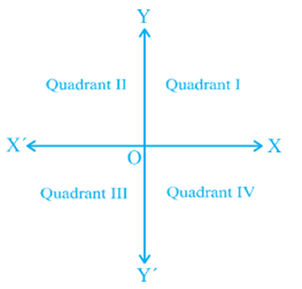
Now, let us see why this system is so basic to mathematics, and how it is useful. Consider the following diagram where the axes are drawn on graph paper. Let us see the distances of the points P and Q from the axes. For this, we draw perpendiculars PM on the x - axis and PN on the y - axis. Similarly, we draw perpendiculars QR and QS as shown in Fig. 3.10.
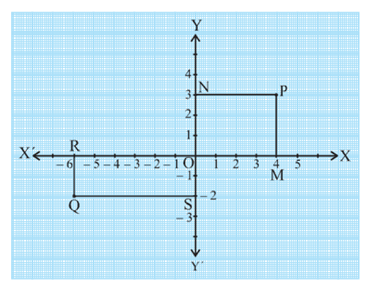
You find that
(i) The perpendicular distance of the point P from the y - axis measured along the positive direction of the x - axis is PN = OM = 4 units.
(ii) The perpendicular distance of the point P from the x - axis measured along the positive direction of the y - axis is PM = ON = 3 units.
(iii) The perpendicular distance of the point Q from the y - axis measured along the negative direction of the x - axis is OR = SQ = 6 units.
(iv) The perpendicular distance of the point Q from the x - axis measured along the negative direction of the y - axis is OS = RQ = 2 units.
Now, using these distances, how can we describe the points so that there is no confusion?
We write the coordinates of a point, using the following conventions:
(i) The x - coor dinate of a point is its perpendicular distance from the y - axis measured along the x -axis (positive along the positive direction of the x - axis and negative along the negative direction of the x - axis). For the point P, it is
+ 4 and for Q, it is – 6. The x - coordinate is also called the abscissa.
(ii) The y - coor dinate of a point is its perpendicular distance from the x - axis measured along the y - axis (positive along the positive direction of the y - axis and negative along the negative direction of the y - axis). For the point P, it is
+ 3 and for Q, it is –2. The y - coordinate is also called the ordinate.
(iii) In stating the coordinates of a point in the coordinate plane, the x - coordinate comes first, and then the y - coordinate. We place the coordinates in brackets.
Hence, the coordinates of P are (4, 3) and the coordinates of Q are (– 6, – 2). Note that the coordinates describe a point in the plane uniquely. (3, 4) is not the same as (4, 3).

 Kaysons Publication
Kaysons Publication
